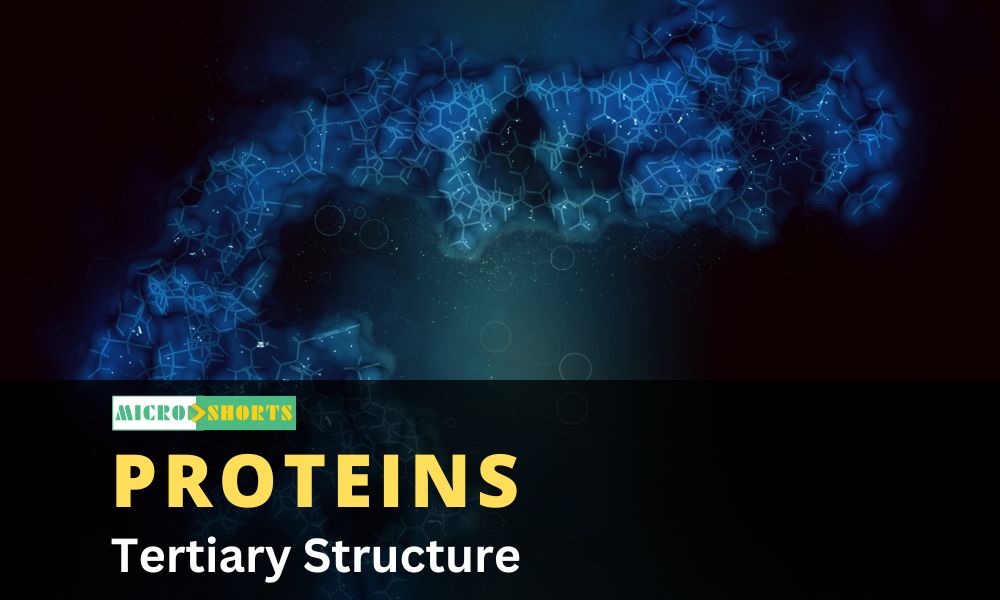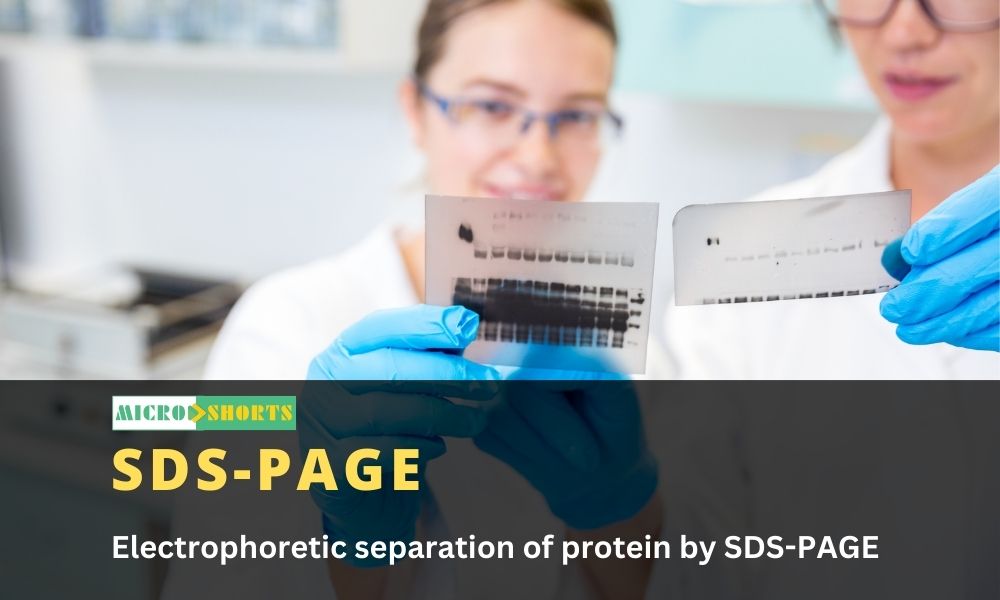The tertiary structure of a protein is the three-dimensional arrangement of all the atoms in the molecule. The conformations of the side chains and the positions of any prosthetic groups are parts of the tertiary structure, as is the arrangement of helical and pleated-sheet sections with respect to one another.
The helical backbone of the protein does not fold back on itself, and the only important aspect of the tertiary structure that is not specified by the secondary structure is the arrangement of the atoms of the side chains.
For a globular protein, considerably more information is needed. It is necessary to determine the way in which the helical and pleated-sheet sections fold back on each other, in addition to the positions of the side-chain atoms and any prosthetic groups.
The interactions between the side chains play an important role in the folding of proteins. The folding pattern frequently brings residues that are separated in the amino acid sequence into proximity in the tertiary structure of the native protein.
Forces Involved in Tertiary Structures
Many types of forces and interactions play a role in holding a protein together in its correct, native conformation. Some of these forces are covalent, but many are not. The primary structure of a protein—the order of amino acids in the polypeptide chain—depends on the formation of peptide bonds, which are covalent.
Higherorder levels of structure, such as the conformation of the backbone (secondary structure) and the positions of all the atoms in the protein (tertiary structure), depend on noncovalent interactions.
If the protein consists of several subunits, the interaction of the subunits (quaternary structure, Section 4-5) also depends on noncovalent interactions. Noncovalent stabilizing forces contribute to the most stable structure for a given protein, the one with the lowest energy. Several types of hydrogen bonding occur in proteins.
Backbone hydrogen bonding is a major determinant of secondary structure; hydrogen bonds between the side chains of amino acids are also possible in proteins. Nonpolar residues tend to cluster together in the interior of protein molecules as a result of hydrophobic interactions.
Electrostatic attraction between oppositely charged groups, which frequently occurs on the surface of the molecule, results in such groups being close to one another.
Several side chains can be complexed to a single metal ion. (Metal ions also occur in some prosthetic groups.) In addition to these noncovalent interactions, disulfide bonds form covalent links between the side chains of cysteines. When such bonds form, they restrict the folding patterns available to polypeptide chains.
There are specialized laboratory methods for determining the number and positions of disulfide links in a given protein. Information about the locations of disulfide links can then be combined with knowledge of the primary structure to give the complete covalent structure of the protein.
Note the subtle difference here: The primary structure is the order of amino acids, whereas the complete covalent structure also specifies the positions of the disulfide bonds (Figure).
Not every protein necessarily exhibits all possible structural features of the kinds just described. For instance, there are no disulfide bridges in myoglobin and hemoglobin, which are oxygen-storage and transport proteins and classic examples of protein structure, but they both contain Fe(II) ions as part of a prosthetic group.
In contrast, the enzymes trypsin and chymotrypsin do not contain complexed metal ions, but they do have disulfide bridges. Hydrogen bonds, electrostatic interactions, and hydrophobic interactions occur in most proteins.
The three-dimensional conformation of a protein is the result of the interplay of all the stabilizing forces. It is known, for example, that proline does not fit into an -helix and that its presence can cause a polypeptide chain to turn a corner, ending an -helical segment.
The presence of proline is not, however, a requirement for a turn in a polypeptide chain. Other residues are routinely encountered at bends in polypeptide chains.
The segments of proteins at bends in the polypeptide chain and in other portions of the protein that are not involved in helical or pleatedsheet structures are frequently referred to as “random” or “random coil.” In reality, the forces that stabilize each protein are responsible for its conformation.
How can the three-dimensional structure of a protein be determined?
The experimental technique used to determine the tertiary structure of a protein is X-ray crystallography.
X-ray crystallography - an experimental method for determining the three-dimensional structure of molecules, such as the tertiary or quaternary structure of proteins
Perfect crystals of some proteins can be grown under carefully controlled conditions. In such a crystal, all the individual protein molecules have the same three-dimensional conformation and the same orientation.
Crystals of this quality can be formed only from proteins of very high purity, and it is not possible to obtain a structure if the protein cannot be crystallized.
When a suitably pure crystal is exposed to a beam of X rays, a diffraction pattern is produced on a photographic plate (Figure A) or a radiation counter.The pattern is produced when the electrons in each atom in the molecule scatter the X rays.
The number of electrons in the atom determines the intensity of its scattering of X rays; heavier atoms scatter more effectively than lighter atoms. The scattered X rays from the individual atoms can reinforce each other or cancel each other (set up constructive or destructive interference), giving rise to the characteristic pattern for each type of molecule.
A series of diffraction patterns taken from several angles contains the information needed to determine the tertiary structure. The information is extracted from the diffraction patterns through a mathematical analysis known as a Fourier series.
Many thousands of such calculations are required to determine the structure of a protein, and even though they are performed by computer, the process is a fairly long one. Improving the calculation procedure is a subject of active research.
Another technique that supplements the results of X-ray diffraction has come into wide use in recent years. It is a form of nuclear magnetic resonance (NMR) spectroscopy. In this particular application of NMR, called 2-D (twodimensional) NMR, large collections of data points are subjected to computer analysis (Figure B).
nuclear magnetic resonance (NMR) spectroscopy - a method for determining the three-dimensional shape of proteins in solution
Like X-ray diffraction, this method uses a Fourier series to analyze results. It is similar to X-ray diffraction in other ways: It is a long process, and it requires considerable amounts of computing power and milligram quantities of protein. One way in which 2-D NMR differs from X-ray diffraction is that it uses protein samples in aqueous solution rather than crystals.
This environment is closer to that of proteins in cells, and thus it is one of the main advantages of the method. The NMR method most widely used in the determination of protein structure ultimately depends on the distances between hydrogen atoms, giving results independent of those obtained by X-ray crystallography.
The NMR method is undergoing constant improvement and is being applied to larger proteins as these improvements progress.
Myoglobin: An Example of Protein Structure
In many ways, myoglobin is the classic example of a globular protein. We shall use it here as a case study in tertiary structure. (We shall see the tertiary structures of many other proteins in context when we discuss their roles in biochemistry.)
Myoglobin was the first protein for which the complete tertiary structure (Figure ) was determined by X-ray crystallography.
The complete myoglobin molecule consists of a single polypeptide chain of 153 amino acid residues and includes a prosthetic group, the heme group, which also occurs in hemoglobin. The myoglobin molecule (including the heme group) has a compact structure, with the interior atoms very close to each other.
Heme - an iron-containing cyclic compound found in cytochromes, hemoglobin, and myoglobin
This structure provides examples of many of the forces responsible for the three-dimensional shapes of proteins. Myoglobin has eight -helical regions and no ‑-pleated sheet regions. Approximately 75% of the residues in myoglobin are found in these helical regions, which are designated by the letters A through H.
Hydrogen bonding in the polypeptide backbone stabilizes the -helical regions; amino acid side chains are also involved in hydrogen bonds. The polar residues are on the exterior of the molecule.
The planar heme group fits into a hydrophobic pocket in the protein portion of the molecule and is held in position by hydrophobic attractions between heme’s porphyrin ring and the nonpolar side chains of the protein.
The presence of the heme group drastically affects the conformation of the polypeptide: The apoprotein (the polypeptide chain alone, without the prosthetic heme group) is not as tightly folded as the complete molecule.
The heme group consists of a metal ion, Fe(II), and an organic part, protoporphyrin IX (Figure ). (The notation Fe(II) is preferred to Fe21 when metal ions occur in complexes.) The porphyrin part consists of four five-membered rings based on the pyrrole structure; these four rings are linked by bridging methine (-CHw) groups to form a square planar structure.
The Fe(II) ion has six coordination sites, and it forms six metal–ion complexation bonds. Four of the six sites are occupied by the nitrogen atoms of the four pyrrole-type rings of the porphyrin to give the complete heme group.
The presence of the heme group is required for myoglobin to bind oxygen. The fifth coordination site of the Fe(II) ion is occupied by one of the nitrogen atoms of the imidazole side chain of histidine residue F8 (the eighth residue in helical segment F).
This histidine residue is one of the two in the interior of the molecule. The oxygen is bound at the sixth coordination site of the iron. The fifth and sixth coordination sites lie perpendicular to, and on opposite sides of, the plane of the porphyrin ring.
The other histidine residue in the interior of the molecule, residue E7 (the seventh residue in helical segment E), lies on the same side of the heme group as the bound oxygen (Figure ).
This second histidine is not bound to the iron, or to any part of the heme group, but it acts as a gate that opens and closes as oxygen enters the hydrophobic pocket to bind to the heme.
The E7 histidine sterically inhibits oxygen from binding perpendicularly to the heme plane, with biologically important ramifications.
Why does oxygen have imperfect binding to the heme group?
At first, it would seem counterintuitive that oxygen would bind imperfectly to the heme group. After all, the job of both myoglobin and hemoglobin is to bind to oxygen.
Wouldn’t it make sense that oxygen should bind strongly? The answer lies in the fact that more than one molecule can bind to heme. Besides oxygen, carbon monoxide also binds to heme.
The affinity of free heme for carbon monoxide (CO) is 25,000 times greater than its affinity for oxygen. When carbon monoxide is forced to bind at an angle in myoglobin because of the steric block by His E7, its advantage over oxygen drops by two orders of magnitude (Figure).
These guards against the possibility that traces of CO produced during metabolism would occupy all the oxygen-binding sites on the hemes. Nevertheless, CO is a potent poison in larger quantities because of its effect both on oxygen binding to hemoglobin and on the final step of the electron transport chain (Section 20-3).
It is also important to remember that although our metabolism requires that hemoglobin and myoglobin bind oxygen, it would be equally disastrous if the heme never let the oxygen go.
Thus, too-perfect binding would defeat the purpose of having the oxygen-carrying proteins. In the absence of the protein, the iron of the heme group can be oxidized to Fe(III); the oxidized heme will not bind oxygen.
Thus, the combination of both heme and protein is needed to bind O2 for oxygen storage.
Denaturation and Refolding
The noncovalent interactions that maintain the three-dimensional structure of a protein are weak, and it is not surprising that they can be disrupted easily. The unfolding of a protein (i.e., disruption of the tertiary structure) is called denaturation.
Denaturation - the unraveling of the three-dimensional structure of a macromolecule caused by the breakdown of noncovalent interactions.
Reduction of disulfide bonds (Section 3-5) leads to even more extensive unraveling of the tertiary structure. Denaturation and reduction of disulfide bonds are frequently combined when complete disruption of the tertiary structure of proteins is desired.
Under proper experimental conditions, the disrupted structure can then be completely recovered. This process of denaturation and refolding is a dramatic demonstration of the relationship between the primary structure of the protein and the forces that determine the tertiary structure.
For many proteins, various other factors are needed for complete refolding, but the important point is that the primary structure determines the tertiary structure. Proteins can be denatured in several ways. One is heated.
An increase in temperature favors vibrations within the molecule, and the energy of these vibrations can become great enough to disrupt the tertiary structure.
At either high or low extremes of pH, at least some of the charges on the protein are missing, and so the electrostatic interactions that would normally stabilize the native, active form of the protein are drastically reduced. This leads to denaturation.
The binding of detergents, such as sodium dodecyl sulfate (SDS), also denatures proteins. Detergents tend to disrupt hydrophobic interactions. If a detergent is charged, it can also disrupt electrostatic interactions within the protein.
Other reagents, such as urea and guanidine hydrochloride, form hydrogen bonds with the protein that are stronger than those within the protein itself. These two reagents can also disrupt hydrophobic interactions in much the same way as detergents (Figure).









Comments